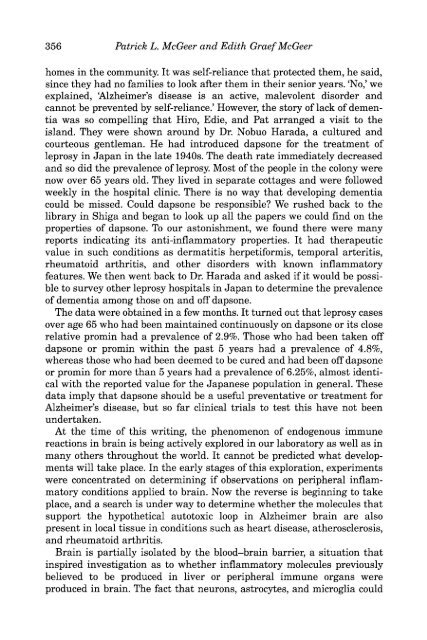Edith Graef McGeer - Society for Neuroscience
Edith Graef McGeer - Society for Neuroscience
Edith Graef McGeer - Society for Neuroscience
You also want an ePaper? Increase the reach of your titles
YUMPU automatically turns print PDFs into web optimized ePapers that Google loves.
356 Patrick L. <strong>McGeer</strong> and <strong>Edith</strong> <strong>Graef</strong><strong>McGeer</strong><br />
homes in the community. It was self-rehance that protected them, he said,<br />
since they had no famihes to look after them in their senior years. 'No,' we<br />
explained, 'Alzheimer's disease is an active, malevolent disorder and<br />
cannot be prevented by self-reliance.' However, the story of lack of dementia<br />
was so compelling that Hiro, Edie, and Pat arranged a visit to the<br />
island. They were shown around by Dr. Nobuo Harada, a cultured and<br />
courteous gentleman. He had introduced dapsone <strong>for</strong> the treatment of<br />
leprosy in Japan in the late 1940s. The death rate immediately decreased<br />
and so did the prevalence of leprosy. Most of the people in the colony were<br />
now over 65 years old. They lived in separate cottages and were followed<br />
weekly in the hospital clinic. There is no way that developing dementia<br />
could be missed. Could dapsone be responsible? We rushed back to the<br />
library in Shiga and began to look up all the papers we could find on the<br />
properties of dapsone. To our astonishment, we found there were many<br />
reports indicating its anti-inflammatory properties. It had therapeutic<br />
value in such conditions as dermatitis herpeti<strong>for</strong>mis, temporal arteritis,<br />
rheumatoid arthritis, and other disorders with known inflammatory<br />
features. We then went back to Dr. Harada and asked if it would be possible<br />
to survey other leprosy hospitals in Japan to determine the prevalence<br />
of dementia among those on and off dapsone.<br />
The data were obtained in a few months. It turned out that leprosy cases<br />
over age 65 who had been maintained continuously on dapsone or its close<br />
relative promin had a prevalence of 2.9%. Those who had been taken off<br />
dapsone or promin within the past 5 years had a prevalence of 4.8%,<br />
whereas those who had been deemed to be cured and had been off dapsone<br />
or promin <strong>for</strong> more than 5 years had a prevalence of 6.25%, almost identical<br />
with the reported value <strong>for</strong> the Japanese population in general. These<br />
data imply that dapsone should be a useful preventative or treatment <strong>for</strong><br />
Alzheimer's disease, but so far clinical trials to test this have not been<br />
undertaken.<br />
At the time of this writing, the phenomenon of endogenous immune<br />
reactions in brain is being actively explored in our laboratory as well as in<br />
many others throughout the world. It cannot be predicted what developments<br />
will take place. In the early stages of this exploration, experiments<br />
were concentrated on determining if observations on peripheral inflammatory<br />
conditions applied to brain. Now the reverse is beginning to take<br />
place, and a search is under way to determine whether the molecules that<br />
support the hypothetical autotoxic loop in Alzheimer brain are also<br />
present in local tissue in conditions such as heart disease, atherosclerosis,<br />
and rheumatoid arthritis.<br />
Brain is partially isolated by the blood-brain barrier, a situation that<br />
inspired investigation as to whether inflammatory molecules previously<br />
believed to be produced in liver or peripheral immune organs were<br />
produced in brain. The fact that neurons, astroc3^es, and microglia could











![[Authors]. [Abstract Title]. - Society for Neuroscience](https://img.yumpu.com/8550710/1/190x245/authors-abstract-title-society-for-neuroscience.jpg?quality=85)





